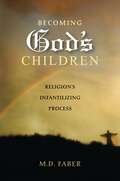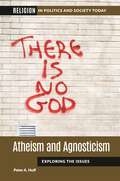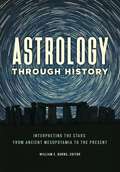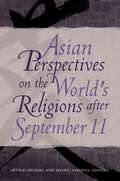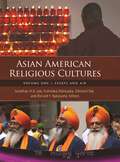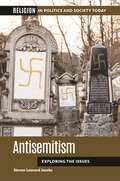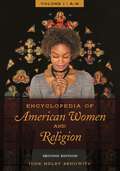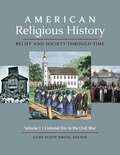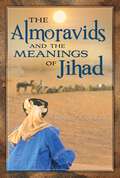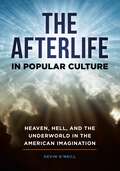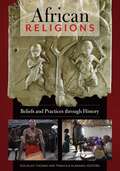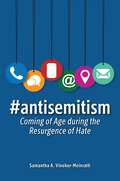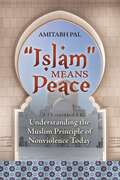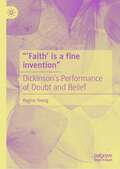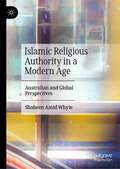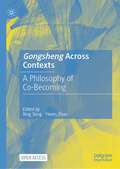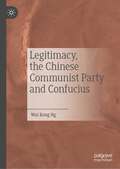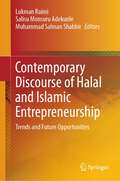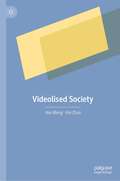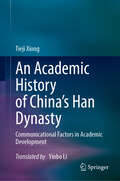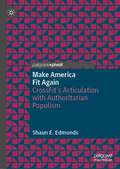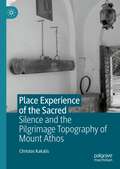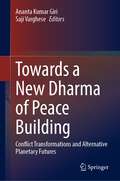- Table View
- List View
Becoming God's Children: Religion's Infantilizing Process
by M. D. FaberM. D. Faber presents a meticulous, unremitting inquiry into the psychological direction from which Christianity derives its power to attract and hold its followers.Becoming God's Children: Religion's Infantilizing Process was written, its author says, to alert readers to the role of infantilization in the Judeo-Christian tradition generally and in Christian rite and doctrine particularly. Because religion plays such an important role in so may lives, it is essential to understand the underlying appeal and significance of religious doctrines.To that end, Becoming God's Children offers the reader an in-depth account of human neuropsychological development, while unearthing the Judeo-Christian tradition's explicitly infantilizing doctrines and rites. This compelling perspective on the nature and meaning of religious behavior explores issues such as: to what extent religious faith is grounded in the mnemonic recesses of the worshipper's brain, whether believers are predisposed by both genetic makeup and environmental prompting to adhere to their religious convictions, and why some individuals are powerfully drawn to religious faith while others reject it. A final chapter explores the implications of religion's infantilizing process vis-a-vis the role of reason and scientific thought in the contemporary world.
Atheism and Agnosticism: Exploring the Issues (Religion in Politics and Society Today)
by Peter A. HuffAn overview essay and approximately 50 alphabetically arranged reference entries explore the background and significance of atheism and agnosticism in modern society.This is the age of atheism and agnosticism. The number of people living without religious belief and practice is quickly and dramatically rising. Some experts call nonreligion, after Christianity and Islam, the third largest "religion" in the world today. Understanding the origins, history, variations, and impact of atheism and agnosticism is crucial to getting a grasp of the meaning of the present and gaining a glimpse of the future.Exploring some of the most extraordinary people, events, and ideas of all time, this book provides a fair, comprehensive, and engaging survey of all aspects of contemporary atheism and agnosticism. An overview essay discusses the background and social and political contexts of unbelief, while a timeline highlights key events. Some 50 alphabetically arranged reference entries follow, with each providing fundamental, objective information about particular topics along with cross-references and suggestions for further reading. The volume closes with an annotated bibliography of the most important resources on atheism and agnosticism.
Astrology through History: Interpreting the Stars from Ancient Mesopotamia to the Present
by William E. BurnsAlphabetically arranged entries cover the history of astrology from ancient Mesopotamia to the 21st century. In addition to surveying the Western tradition, the book explores Islamic, Indian, East Asian, and Mesoamerican astrology.The field of astrology is growing rapidly, as historians recognize its centrality to the intellectual life of the past and sociologists and anthropologists treat its importance in a number of modern cultures. Despite the historical and cultural significance of the subject, most reference works on astrology focus on instructional techniques and are written by astrologers with little or no interest in the history of the topic. This book instead offers an objective treatment of astrology across world history from ancient Mesopotamia to the present.The book provides alphabetically arranged entries by expert contributors writing on such topics as horoscopes, court astrologers, Renaissance astrology, and comets. While it considers the Western tradition, it also treats Islamic, Indian, East Asian, and Mesoamerican astrology. In doing so, it explores the role of astrology in shaping science, literature, religion, art, and other defining cultural traditions. Sidebars offer excerpts from various historical texts, while entries provide suggestions for further reading.
Asian Perspectives on the World's Religions after September 11
by Arvind Sharma and Madhu KhannaThis book offers a unique perspective on September 11 and our world after this tragic event, sharing lessons from an Asian religious experience that can help heal a world troubled by religious conflicts and deepening divisions, and promote a positive global transformation.Existing literature regarding the events of September 11 and our world afterward has focused mostly on the West and the Middle East. Asian Perspectives on the World's Religions after September 11 extends this discussion to include Asia—a continent and culture far too important to be ignored in any assessment of the global impact of this event. The book is organized along the following themes, as they emerged post-September 11th: religion and civilizational dialogue; religion, conflict, and peace; religion and human rights; religion and ethics; religion and the arts; religion, hermeneutics, and literature; religion and gender; religion and ecology; and religion and globalization. Individuals who are studying or teaching political science, international relations, philosophy, ethics, Asian studies, or religious studies will find the text invaluable, while general readers will appreciate the largely unvoiced Asian perspective on this topic.
Asian American Religious Cultures [2 volumes]: [2 volumes] (American Religious Cultures)
by Jonathan H. X. Lee, Fumitaka Matsuoka, Edmond Yee, and Ronald Y. Nakasone, EditorsA resource ideal for students as well as general readers, this two-volume encyclopedia examines the diversity of the Asian American and Pacific Islander spiritual experience.Despite constituting a fairly small proportion of the U.S. population—roughly 5 percent—Asian Americans are a widely diverse group with equally heterogeneous religious beliefs and traditions. This encyclopedia provides a single source for authoritative information on the Asian American and Pacific Islander religious experience, addressing South Asian Americans, such as Indian Americans and Pakistani Americans; East Asian Americans, including Chinese Americans, Japanese Americans, and Korean Americans; and Southeast Asian Americans, whose ethnicities include Filipino Americans, Thai Americans, and Vietnamese Americans. Pacific Islanders include Hawaiians, Samoans, Marshallese, Tongan, and Chamorro. The coverage includes not only traditional eastern belief systems and traditions such as Buddhism, Confucianism, and Hinduism as well as Micronesian and Polynesian religious traditions in the United States, but also the culture and religious rituals of Asian American Christians.
Antisemitism: Exploring the Issues (Religion in Politics and Society Today)
by Steven Leonard JacobsWith an overview essay, timeline, reference entries, and annotated bibliography, this resource is a concise, one-stop reference on antisemitism in today's society.Stretching back to biblical times, antisemitism is perhaps the world's oldest hatred of a group. It has manifested itself around the world, sometimes taking the form of superficially innocent jokes and at other times promoting such tragedies as the Holocaust. Far from disappeared, its continued existence in today's society is evidenced by vandalism of Jewish cemeteries and shootings at synagogues. This book explores the causes and consequences of contemporary antisemitism, placing this form of hatred in its historical, political, and social contexts.An overview essay surveys the background and significance of antisemitism and provides historical context for discussions of contemporary topics. A timeline highlights key events related to antisemitism. Some 50 alphabetically arranged reference entries provide objective, fundamental information about people, events, and other topics related to antisemitism. These entries cite works for further reading and provide cross-references to related topics. An annotated bibliography cites and evaluates some of the most important resources on antisemitism suitable for student research.
Encyclopedia of American Women and Religion [2 volumes]: [2 volumes]
by June Melby BenowitzThis two-volume set examines women's contributions to religious and moral development in America, covering individual women, their faith-related organizations, and women's roles and experiences in the broader social and cultural contexts of their times.This second edition of Encyclopedia of American Women and Religion provides updated and expanded information from historians and other scholars of religion, covering new issues in religion to better describe and document women's roles within religious groups. For instance, the term "evangelical feminism" is one newly defined aspect of women's involvement in religious activism. Changes are constantly occurring within the many religious faiths and denominations in America, particularly as women strive to gain positions within religious hierarchies that previously were exclusive to men and rise within their denominations to become theologians, church leaders, and bishops.The entries examine the roles that American women have played in mainstream religious denominations, small religious sects, and non-traditional practices such as witchcraft, as well as in groups that question religious beliefs, including agnostics and atheists. A section containing primary documents gives readers a firsthand look at matters of concern to religious women and their organizations. Many of these documents are the writings of women who merit entries within the encyclopedia. Readers will gain an awareness of women's contributions to religious culture in America, from the colonial era to the present day, and better understand the many challenges that women have faced to achieve success in their religion-related endeavors.
American Religious History [3 volumes]: Belief and Society through Time [3 volumes]
by Gary Scott SmithA mix of thematic essays, reference entries, and primary source documents covering the role of religion in American history and life from the colonial era to the present.Often controversial, religion has been an important force in shaping American culture. Religious convictions strongly influenced colonial and state governments as well as the United States as a new republic. Religious teachings, values, and practices deeply affected political structures and policies, economic ideology and practice, educational institutions and instruction, social norms and customs, marriage, and family life. By analyzing religion's interaction with American culture and prominent religious leaders and ideologies, this reference helps readers to better understand many fascinating, often controversial, religious leaders, ideas, events, and topics.The work is organized in three volumes devoted to particular periods. Volume one includes a chronology highlighting key events related to religion in American history and an introduction that overviews religion in America during the period covered by the volume, and roughly 10 essays that explore significant themes. These essays are followed by approximately 120 alphabetically arranged reference entries providing objective, fundamental information about topics related to religion in America. Each volume presents nearly 50 primary source documents, each introduced by a contextualizing headnote. A selected, general bibliography closes volume three.
The Almoravids and the Meanings of Jihad
by Ronald A. MessierThis book offers a scholarly, highly readable account of the 11th-12th century rulers of Morocco and Muslim Spain who offered a full range of meanings of jihad and challenged Ibn Khaldun's paradigm for the rise and fall of regimes.Originally West African, Berber nomads, the Almoravids emerged from what is today Mauritania to rule Morocco, western Algeria, and Muslim Spain. Over the course of the century-long lifespan of the Almoravid dynasty, the concept of jihad evolved through four distinct phases: a struggle for righteousness, a war against pagans in the Sahara to impose their own sense of righteousness, war against "bad" Muslims in Sijilmasa and the rest of the Maghrib, and finally, war against Christian infidels—the Christian kings of Iberia.The Almoravids and the Meanings of Jihad takes readers through a clear chronology of the dynasty from its birth through its dramatic rise to power, then its decline and eventual collapse. Several important themes in North African history are explored throughout the book, including the dynastic theory of noted Arab historian Ibn Khaldun, the unique relationship of rural and urban lifestyles, the interactions of distinct Berber and Arab identities, and the influence of tribal solidarity and Islam in forming the social fabric of medieval North African society
The Afterlife in Popular Culture: Heaven, Hell, and the Underworld in the American Imagination
by Kevin O'NeillThe Afterlife in Popular Culture: Heaven, Hell, and the Underworld in the American Imagination gives students a fresh look at how Americans view the afterlife, helping readers understand how it's depicted in popular culture.What happens to us when we die? The book seeks to explore how that question has been answered in American popular culture. It begins with five framing essays that provide historical and intellectual background on ideas about the afterlife in Western culture. These essays are followed by more than 100 entries, each focusing on specific cultural products or authors that feature the afterlife front and center. Entry topics include novels, film, television shows, plays, works of nonfiction, graphic novels, and more, all of which address some aspect of what may await us after our passing.This book is unique in marrying a historical overview of the afterlife with detailed analyses of particular cultural products, such as films and novels. In addition, it covers these topics in nonspecialist language, written with a student audience in mind. The book provides historical context for contemporary depictions of the afterlife addressed in the entries, which deal specifically with work produced in the 20th and 21st centuries.
African Religions: Beliefs and Practices through History
by Douglas Thomas and Temilola AlanamuThis book supplies fundamental information about the diverse religious beliefs of Africa, explains central tenets of the African worldview, and overviews various forms of African spiritual practices and experiences.Africa is an ancient land with a significant presence in world history—especially regarding the history of the United States, given the ethnic origins of a substantial proportion of the nation's population. This book presents a broad range of information about the diverse religious beliefs of Africa that serves to describe the beliefs, practices, deities, sacred places, and creation stories of African religions. Readers will learn about key forms of spiritual practices and experiences, such as incantations and prayer, dance as worship, and spirit possession, all of which pepper African American religious experiences today. The entries also discuss central tenets of the African worldview—for example, the belief that humankind is not to fight nature, but to integrate into the natural environment.This volume is specifically written to be highly accessible to students. It provides a much-needed source of connections between the religious traditions and practices of African Americans and those of the people of the continent of Africa. Through these connections, this work will inspire tolerance of other religions, traditions, and backgrounds. The included selection of primary documents provides users first-hand accounts of African religious beliefs and practices, serving to promote critical thinking skills and support Common Core State Standards.
#antisemitism: Coming of Age during the Resurgence of Hate
by Samantha A. Vinokor-MeinrathExploring what it means to come of age in an era marked by increasing antisemitism, readers see through the eyes of Jewish Gen Zers how identities are shaped in response to and in defiance of antisemitism.Using personal experiences, qualitative research, and the historic moment in which Generation Z is coming of age, Jewish educator Samantha Vinokor-Meinrath uses antisemitism from both the political left and the right to explore identity development among Jewish Generation Zers. With insights from educators, students, activists, and more, she holds a lens up to current antisemitism and its impact on the choices and opinions of the next generation of Jewish leaders.Chapters cover Holocaust education for the final generation able to speak directly to Holocaust survivors and learn their stories firsthand; anti-Zionism as a modern manifestation of antisemitism; and how the realities of 21st-century America have shaped the modern Jewish experience, ranging from the synagogue shooting in Pittsburgh to how Generation Zers use social media and understand diversity. The core of this book is a collection of stories: of intersectional identity, of minority affiliations, and of overcoming adversity in order to flourish and thrive.
"Islam" Means Peace: Understanding the Muslim Principle of Nonviolence Today
by Amitabh PalThis decisive account of the role of nonviolence in Islam and Muslim societies, both historically and in current times, chronicles an often-obscured but longstanding pacifist tradition."Islam" Means Peace: Understanding the Muslim Principle of Nonviolence Today provides a rebuttal to general misperceptions about the religion by documenting its rich tradition of nonviolence. To that end, the book examines the sources of Islam—the Qur'an, the main religious text of Islam, and the Hadith, the deeds and sayings of the Prophet Muhammad. It contests the prevalent notion that Islam is built on violence in part by illuminating the role of the tolerant, mystical tradition of Sufism in Islam, while at the same time examining the misunderstood place of jihad in the religion. The book is not, however, a historical or theological treatise. Rather, it focuses on the tradition of nonviolence in modern Muslim societies. By spotlighting recent peaceful protest movements in Muslim communities, the book underscores the truly global and multicultural nature of the Islamic tradition of nonviolence. The findings here will be invaluable for Muslims and non-Muslims alike, revealing an alternative tradition both can embrace.
Buddho
by Ajahn Tate Thanissaro BhikkhuA simple and practical guide to the use of the meditation phrase buddho, which is used to settle the mind to the point at which discernment can begin to arise.
Steps Along the Path
by Ajahn Tate Thanissaro BhikkhuA short handbook on the practice of meditation with tips and recommendations for new and experienced meditators, with a discussion of how best to respond when visions and signs arise.
“‘Faith’ is a fine invention”: Dickinson’s Performance of Doubt and Belief
by Regina YoongThis book covers nineteenth-century American poet Emily Dickinson who captured the multifaceted nature of life in all of its uncertainties. Studies on her exploration of faith are ample, but in this book, the author uncovers Dickinson’s playful role-play in enacting solemn themes of religion, death, and the unknown. Dickinson’s creativity encompasses not only her use of language but also her poetic personae and self-created poetic stages inviting readers to question, contemplate deeply or even poke fun at life's absurdities. By using performative roles such as the rejected outcast, passive supplicant, and playful warrior, Dickinson unveils--through a paradoxical framework of belief and unbelief-- a line of inquiry that is multifocal and erratic to “tell all the truth and tell it slant.”
Islamic Religious Authority in a Modern Age: Australian and Global Perspectives
by Shaheen Amid WhyteThis book situates Australian Muslim experiences of religious authority within the global context of Islam in the modern world. While drawing on examples of Muslim-majority states, new empirical findings indicate the growing diversity of Muslim religious actors in Australia, as well as the contextual realities shaping the way religious authority is legitimised and contested in democratic and authoritarian environments. In particular, the study challenges homogenous articulations of Islamic religious authority in unearthing new voices, epistemologies and socio-political factors shaping Muslim attitudes and experiences of religious authority. The book fills important gaps in the field, such as intra-Muslim relations, female religious authority, digital Islam and the relationship between traditional ulama, reformists and Muslim intellectuals in the West.
Gongsheng Across Contexts: A Philosophy of Co-Becoming
by Bing Song Yiwen ZhanThis open access book sheds light on the term gongsheng/kyōsei, which is used in Chinese and Japanese to not only translate “symbiosis” in biology but also broadly deployed in philosophical, social and political contexts. It is a cross-contextual attempt to study the foundation of gongsheng/kyōsei as a philosophy of co-becoming, with exploration of its significance for thinking about the planetary challenges of our times.
Legitimacy, the Chinese Communist Party and Confucius
by Wai Kong NgThis book explores the use of Confucianism by the Chinese Communist Party in its assertion of political legitimacy. Confucian thought offers an enduring framework for political legitimacy in East Asian societies, including China. All states strive to acquire legitimacy, and despite once denouncing Confucianism as the remnants of feudal poison, the Party is turning towards Confucianism as part of its legitimation efforts. This suggests that the Party is suffering from an ideological void in terms of legitimacy and legitimation due to the diminishing relevance of Marxism in Chinese societal practices. The book will devise a non-liberal legitimacy framework, drawing on the ideas of Habermas and Bernard Williams, to examine the legitimacy of the Party, and use an analysis of the elite discourse to determine the nature of the Confucian turn, in a sharp polemic that will interest scholars of Chinese politics, of the role of traditional beliefs in Asian modernity, and in China's future.
Contemporary Discourse of Halal and Islamic Entrepreneurship: Trends and Future Opportunities
by Lukman Raimi Salisu Monsuru Adekunle Muhammad Salman ShabbirThis book serves as a valuable resource for Islamic entrepreneurship researchers, Halal scholars, Islamic finance professionals, Halal advocates, and Halal business model consultants in the fast-changing global economy. The thematic focus is not only on Islamic and halal entrepreneurship but also on halal production and consumption, ethics and impact investing in Islamic entrepreneurship, Shariah principles guiding business model innovation and utilisation of disruptive technologies (such as crowdfunding for startups, bitcoin, digital ventures, cryptocurrency, blockchain, among others), Islamic entrepreneurship and SDGs, halalisation and sustainability issues, and emergence of Islamic-Fintech in Muslim majority nations and nations with plural economic systems, including the interface of Islamic and halal entrepreneurship with science, technology, engineering, and mathematics (STEM). At the moment, the working knowledge about Islamic and halal entrepreneurship is at its infancy among Islamic finance professionals, halal consultants, academic researchers, and students nursing the ambition of going into these two fields. Universities, Islamic training academies, and centres are also ill equipped to enrich Islamic and halal curricula with principles and conventional models. One of the proactive ways of breaking financial exclusion, social inequality, and social exclusion caused by apathy and avoidance of Riba, Maysir, and Gharar is by recognising, embracing, and promoting Islamic and halal entrepreneurship among the excluded Muslims and lovers of ethical business models. Overall, this book aims to promote better understanding of Islamic and Halal entrepreneurship in order to assist academics, researchers, practitioners, consultants, and policymakers to improve the growth of Islamic startups and small and medium enterprises (SMEs) by improving social inclusion and financial inclusion and accelerating the attainment of SDG 8 and SDG12.
Videolised Society
by Jian Meng Hui ZhaoThis book traces the development of video (especially short video, duan shipin) in China over the past few years, exploring how these videos engaged with China’s rapidly changing society, how they enriched existed theories of society, media and communication, and new theories to be extracted. The book offers a new, critical model for understanding the relationship between video, video theory, video industry and the State. This book sheds light on the overall description and explanation of the current socio-political, economic and cultural environment concerning the development of video (especially short video). It interprets the emergence of the “Social Videolization” through the subjects of media psychology, communication studies and cultural criticism, media industrial studies, sociology and anthropology.
An Academic History of China's Han Dynasty: Volume I Communicational Factors in Academic Development
by Tieji XiongThis book offers an innovative take on the study of Chinese academic history, approaching the subject from the perspective of broader social and cultural developments, one that is not only comprehensive and inclusive, but also sheds new light on the subject. The book investigates the main academic developments of the Han Dynasty, such as the formation of new-Confucianism and the new-Daoism of Han, the establishment of history studies, advances in astronomy and geography, breakthroughs in agronomy and hydraulics, and the achievements in traditional Chinese medicine. It also explores the cultural and political backgrounds, the main influencing factors, and the main features of academic developments, especially academic carriers and Chinese hermeneutics. It provides a new paradigm for academic history studies and includes many new theories, e.g., the reconstruction of the pre-Qin academics by the Han scholars. This book offers a unique resource for all those who want to learn about and understand Chinese history and culture, especially the academic history of the Han Dynasty.
Make America Fit Again: CrossFit’s Articulation with Authoritarian Populism
by Shaun E. EdmondsThis book critically examines the CrossFit phenomenon and makes the argument that CrossFit uses the rhetoric and tactics found in modern forms of authoritarian populism to rally adherents around its brand. CrossFit is a private branded fitness organization whose unorthodox methods and adversarial leadership has challenged dominant ideas around health and fitness worldwide. In exploring CrossFit’s articulations with healthism and the obesity epidemic, the risk discourse of the prepper and survivalist movements, and the increasing valorization of the military and military personnel, Shaun E. Edmonds makes legible the ideological underpinnings of the CrossFit practice. After a deeper look at how CrossFit’s variation of authoritarian populism has been used to counter critics and mobilize the community, the book concludes by considering what might be next for CrossFit following former CEO and co-founder Greg Glassman’s controversial departure from the company.
Place Experience of the Sacred: Silence and the Pilgrimage Topography of Mount Athos
by Christos KakalisThis book explores the topography of Mount Athos, emphasizing the significance of silence and communal ritual in its understanding. Mount Athos, a mountainous peninsula in northern Greece, is a valuable case study of sacred topography, as it is one of the world’s largest monastic communities and an important pilgrimage destination. Its phenomenological examination highlights the importance of embodiment in the experience of religious places. Combining interdisciplinary insights from architectural theory, philosophy, theology and anthropology with archival and ethnographic materials, the book brings a fresh contribution to both Athonite studies and scholarship on sacred space. By focusing on the interrelation between silence and communal ritual, it offers an alternative to the traditional art historical, objectifying approaches. It reintroduces the phenomenological understanding of place, investigating also how this is expressed through a number of narratives, such as travel literature, maps and diaries.
Towards a New Dharma of Peace Building: Conflict Transformations and Alternative Planetary Futures
by Ananta Kumar Giri Saji VargheseThis volume deals with a new Dharma of peacebuilding and conflict transformations, drawing on the world's philosophical, religious, and spiritual traditions and many recent initiatives and experiments with peace. It deals with issues of sustainable peace, Dharma and Ubuntu of peace from African traditions, neurological insights of peacebuilding, traditions of conscientious objection, Satyagraha, possibilities of Gandhian Ahimsa, and moral and ethical limits of conflict and conflict resolution. It also presents the works of peace thinkers and activists such as Spinoza, Abhinavagupta, Tolstoy, Gandhi, Ulrich Beck, and others. It offers new initiatives and experiments in peace in different parts of the world—Palestine-Israel, Colombia, the Middle East, India, and South Africa. This pioneering and handy book is of interest to students, scholars, teachers, and activists working in peace and conflict studies, development studies, cultural studies, and religious studies as well as in different civil society organizations around the world.
